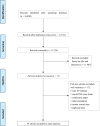Seroprevalence of H7N9 infection among humans: A systematic review and meta-analysis
- PMID: 32157809
- PMCID: PMC7431636
- DOI: 10.1111/irv.12736
Seroprevalence of H7N9 infection among humans: A systematic review and meta-analysis
Abstract
In spring 2013, a novel avian-origin influenza A (H7N9) virus emerged in mainland China. The burden of H7N9 infection was estimated based on systematic review and meta-analysis. The systematic search for available literature was conducted using Chinese and English databases. We calculated the pooled seroprevalence of H7N9 infection and its 95% confidence interval by using Freeman-Tukey double arcsine transformation. Out of 16 890 records found using Chinese and English databases, 54 articles were included in the meta-analysis. These included studies of a total of 64 107 individuals. The pooled seroprevalence of H7N9 infection among humans was 0.122% (95% CI: 0.023, 0.275). In high-risk populations, the highest pooled seroprevalence was observed among close contacts (1.075%, 95% CI: 0.000, 4.357). The seroprevalence among general population was (0.077%, 95% CI: 0.011, 0.180). Our study discovered that asymptomatic infection of H7N9 virus did occur, even if the seroprevalence among humans was low.
Keywords: H7N9; influenza A; meta-analysis; seroprevalence; systematic review.
© 2020 The Authors. Influenza and Other Respiratory Viruses Published by John Wiley & Sons Ltd.
Conflict of interest statement
The authors declare that they have no competing interests.
Figures
Similar articles
-
Serological Evidence of Human Infection With Avian Influenza A(H7N9) Virus: A Systematic Review and Meta-analysis.J Infect Dis. 2022 Aug 12;226(1):70-82. doi: 10.1093/infdis/jiaa679. J Infect Dis. 2022. PMID: 33119755 Free PMC article.
-
Sero-epidemiologic study of influenza A(H7N9) infection among exposed populations, China 2013-2014.Influenza Other Respir Viruses. 2017 Mar;11(2):170-176. doi: 10.1111/irv.12435. Epub 2017 Jan 21. Influenza Other Respir Viruses. 2017. PMID: 27762061 Free PMC article.
-
Epidemiology of human influenza A(H7N9) infection in Hong Kong.J Microbiol Immunol Infect. 2017 Apr;50(2):183-188. doi: 10.1016/j.jmii.2015.06.004. Epub 2015 Jun 30. J Microbiol Immunol Infect. 2017. PMID: 26220305
-
Seroprevalence to avian influenza A(H7N9) virus among poultry workers and the general population in southern China: a longitudinal study.Clin Infect Dis. 2014 Sep 15;59(6):e76-83. doi: 10.1093/cid/ciu399. Epub 2014 May 27. Clin Infect Dis. 2014. PMID: 24867786 Free PMC article.
-
Vaccination of poultry successfully eliminated human infection with H7N9 virus in China.Sci China Life Sci. 2018 Dec;61(12):1465-1473. doi: 10.1007/s11427-018-9420-1. Epub 2018 Nov 7. Sci China Life Sci. 2018. PMID: 30414008 Review.
Cited by
-
Viral factors underlying the pandemic potential of influenza viruses.Microbiol Mol Biol Rev. 2025 Jun 25;89(2):e0006624. doi: 10.1128/mmbr.00066-24. Epub 2025 May 9. Microbiol Mol Biol Rev. 2025. PMID: 40340558 Review.
-
Travel health risk perceptions of Chinese international students in Australia - Implications for COVID-19.Infect Dis Health. 2020 Aug;25(3):197-204. doi: 10.1016/j.idh.2020.03.002. Epub 2020 Apr 4. Infect Dis Health. 2020. PMID: 32291244 Free PMC article.
-
Pain management during the withholding and withdrawal of life support in critically ill patients at the end-of-life: a systematic review and meta-analysis.Intensive Care Med. 2020 Sep;46(9):1671-1682. doi: 10.1007/s00134-020-06139-7. Epub 2020 Aug 24. Intensive Care Med. 2020. PMID: 32833041 Free PMC article.
-
Serological Evidence of Human Infection With Avian Influenza A(H7N9) Virus: A Systematic Review and Meta-analysis.J Infect Dis. 2022 Aug 12;226(1):70-82. doi: 10.1093/infdis/jiaa679. J Infect Dis. 2022. PMID: 33119755 Free PMC article.
-
A codon usage-based approach for the stratification of Influenza A across recent spillovers.Comput Struct Biotechnol J. 2025 Jun 25;27:2757-2771. doi: 10.1016/j.csbj.2025.06.030. eCollection 2025. Comput Struct Biotechnol J. 2025. PMID: 40673124 Free PMC article.
References
-
- Gao RB, Cao B, Hu YW, et al. Human infection with a novel avian‐origin influenza A (H7N9) virus. N Engl J Med. 2013;368(20):1888‐1897. - PubMed
-
- World Health Organization . Human Infection with Avian Influenza A (H7N9) Virus – China: Update. https://www.who.int/csr/don/05‐september‐2018‐ah7n9‐china/en/. Accessed December 30, 2018.
Publication types
MeSH terms
LinkOut - more resources
Full Text Sources
Medical



